Gardener Shares 11 Head-Turning Aster Varieties For Late Summer Colour

PERENNIALS > ASTERS > VARIETIES
Chris is a gardening writer and nature enthusiast. He graduated from Oxford Brookes University in 2022 with an MA in Psychology. Chris works with the Leeds Green Action Society, helping their food cooperative by growing various fruit and vegetables on their two allotments in Hyde Park, Leeds.
Reviewed By DAN ORI

Dan has over 27 years’ under his belt caring for plants and gardens. Working as a Horticultural Instructor and Consultant, he draws on a diverse range of experience that includes working as a Head Gardener, Tree Surgeon, Garden Centre Trouble Shooter, and writer of academic papers. Dan has a Level 3 Diploma in Horticulture and is currently a candidate for the RHS’s most prestigious award – The Master of Horticulture.
IN THIS GUIDE
- 1) Aster alpinus
- 2) A. amellus
- 3) A. x frikartii ‘Mönch’
- 4) Eurybia x herveyi
- 5) A. tongolensis
- 6) Symphyotrichum novae-angliae ‘James Ritchie’
- 7) A. × frikartii ‘Wunder von Stäfa’
- 8) A. ‘Connecticut Snow Flurry’
- 9) A. lateriflorus var. horizontalis
- 10) Symphyotrichum laeve ‘Nightshade’
- 11) Symphyotrichum novae-angliae ‘Brunswick’
ASTERS GUIDES
Container Growing
Growing From Seed
Transplanting
Propagation
Varieties
Asters look a little like daises, boasting star-shaped flowers and a colour palette that encompasses a delightful array of blues, whites, pinks and purples.
These plants are a reliable way to bring colour to your garden, and they’re loved by gardeners far and wide as a result.
With so many types available, though, it can be hard to know where to start.
Height, colour and size should be something you think about when choosing which variety to grow.
There are a great many different Asters that you might consider choosing for your garden.
Below you can find eleven of my favourite varieties to get you started:
1) Aster alpinus

- HARDINESS RATING: H7
- FLOWERS: White, blue, purple and yellow (depends on cultivar)
- FLOWERING SEASON(S): Spring / Summer / Autumn
- SUNLIGHT: Full Sun / Partial Shade
- EXPOSURE: Exposed / Sheltered
- SIZE: 0.1-0.5m in height, 0.1-0.5m spread
A great Aster and one that’s loved by many a British gardener, with good reason!
This Aster is a recipient of the Royal Horticultural Society’s Award of Garden Merit (AGM).
This means that it’s very well suited to growing in UK gardens and that it will attract an entourage of winged critters to your garden.
Doing best in full sun in any but a west-facing aspect, the Aster is hardy down to even the chilliest of UK temperatures.
Grow this variety in chalk, loam or sand and you should get a healthy blue/purple bloom in the summer.
2) A. amellus

- COMMON NAME(S): Italian Aster
- HARDINESS RATING: H7
- FLOWERS: Pink, blue, purple and yellow (depends on cultivar)
- FLOWERING SEASON(S): Summer / Autumn
- SUNLIGHT: Full Sun
- EXPOSURE: Exposed / Sheltered
- SIZE: 0.5-1m in height, 0.5-1m spread
The A. amellus is just as lovely as A. alpinus.
Like we said just now: this indicates that the variety is well suited to growing in UK conditions – a great thing to keep an eye out for when choosing varieties.
Grow this variety in full sun or partial shade, in any soil but clay.
Avoid soil with an acidic pH for optimal results.
Get the conditions right and you’ll get a vibrant bloom in the summer, again encompassing blue and purple with the characteristic smattering of yellow.
3) A. x frikartii ‘Mönch’
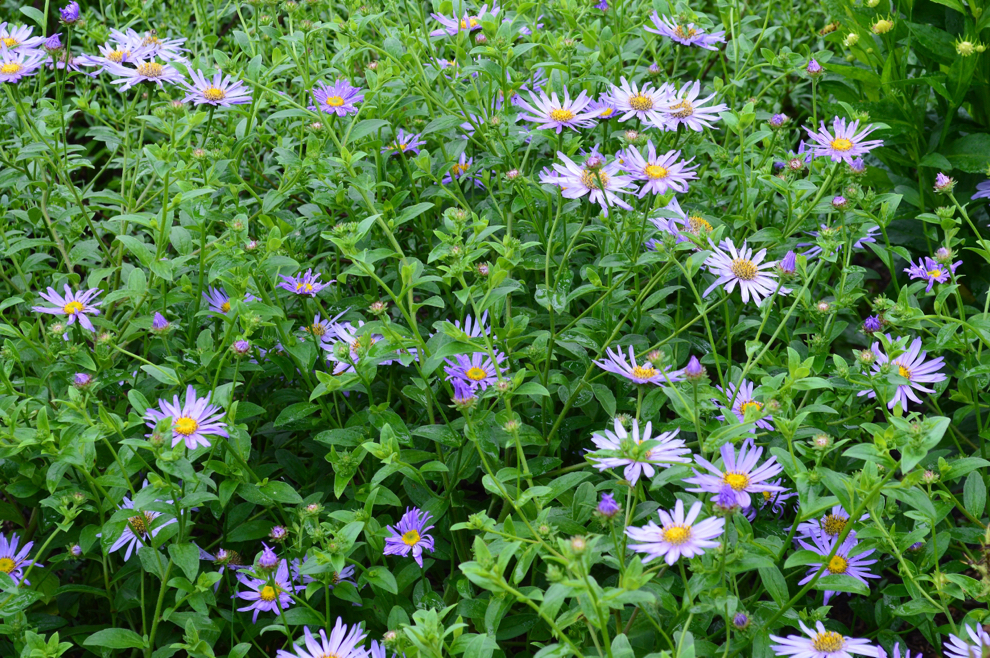
- COMMON NAME(S): Aster ‘Mönch’
- HARDINESS RATING: H7
- FLOWERS: Blue and yellow
- FLOWERING SEASON(S): Summer / Autumn
- SUNLIGHT: Full Sun
- EXPOSURE: Exposed / Sheltered
- SIZE: 0.5-1m in height, 0.1-0.5m spread
This variety yields lavender-coloured flowers, which are a pleasure to behold and has been awarded an AGM.
It’s hardy down to the very coldest temperatures we’ll ever see in the UK and thrives in full sun.
Avoid clay soil and ensure good drainage, and you’ll be rewarded with a bloom that extends a little later into the year than the varieties we’ve seen previously.
4) Eurybia x herveyi
- COMMON NAME(S): Hervey’s Aster
- HARDINESS RATING: H7
- FLOWERS: White or pale blue
- FLOWERING SEASON(S): Summer / Autumn
- SUNLIGHT: Full Sun / Partial Shade
- EXPOSURE: Exposed / Sheltered
- SIZE: 0.5-1m in height, 0.1-0.5m spread
Hervey’s Aster is so called for reasons that are lost to time, but whoever they were, they should be proud of their namesake!
You may also see the variety called ‘Twilight’ and, with the dramatic blue-purple colouration, it’s easy to see why.
This variety likes clay, loam or sand, and will do best if grown in full sun or partial shade.
It’s hardy and resilient and will take between 2-5 years to reach its full size.
Blooms occur in summer and last into autumn, making this a great choice if you want to extend your garden’s season of visual interest.
5) A. tongolensis
- HARDINESS RATING: H6
- FLOWERS: Orange, yellow, purple and blue
- FLOWERING SEASON(S): Summer
- SUNLIGHT: Full Sun
- EXPOSURE: Exposed / Sheltered
- SIZE: 0.1-0.5m in height, 0.1-0.5m spread
This mat-forming Aster variety sports tall flowers that reach high from the ground.
Their colour is more subtle than other varieties, but the lower boldness does definitely not mean less character or attractiveness.
Aim for chalk, loam or sand soil, with any pH.
Full sun suits this variety best, and it’ll burst into bloom in the summer months.
You can expect a range of colours from this variety, including orange and purple.
This plant has received the RHS Plants for Pollinators Status.
6) Symphyotrichum novae-angliae ‘James Ritchie’

- COMMON NAME(S): New England Aster ‘James Ritchie’
- HARDINESS RATING: H7
- FLOWERS: Pink, purple and yellow
- FLOWERING SEASON(S): Autumn
- SUNLIGHT: Full Sun / Partial Shade
- EXPOSURE: Exposed / Sheltered
- SIZE: 1-1.5m in height, 0.5-1m spread
‘James Ritchie’ sounds like a guy you might find at the office, but it’s actually a stunning bright-pink Aster variety.
Its rough leaves support the bold and vibrant bloom every autumn, guaranteed to delight visitors to your garden.
‘James Ritchie’ isn’t fussy: it likes any soil type, any acidity, and any aspect.
It will do well in full sun or partial shade and is hardy down to very low temperatures and definitely hardy enough to withstand anything the UK climate can throw at it.
All of this makes it a worthy recipient of the RHS AGM.
7) A. × frikartii ‘Wunder von Stäfa’
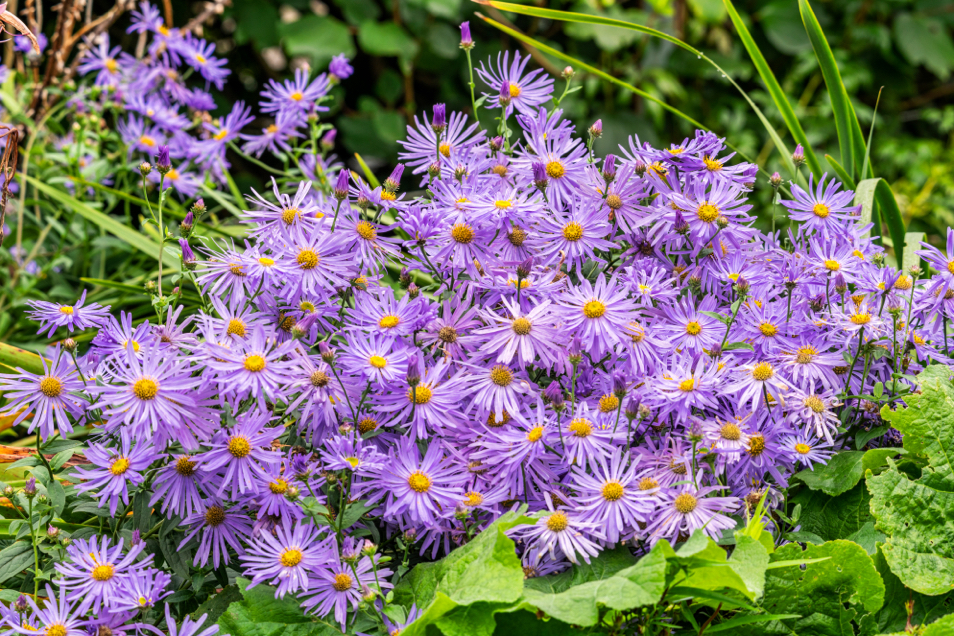
- COMMON NAME(S): Aster ‘Wunder von Stäfa’
- HARDINESS RATING: H7
- FLOWERS: Blue
- FLOWERING SEASON(S): Summer / Autumn
- SUNLIGHT: Full Sun
- EXPOSURE: Exposed / Sheltered
- SIZE: 0.5-1m in height, 0.1-0.5m spread
Here’s another Aster that’s received the RHS AGM.
We love varieties that have both: they’re sure to grow well in your garden, and they bring a bit of life to the space.
There’s nothing more lovely than the buzz of bees and butterflies in your garden.
This variety likes chalk, loam or sand, and requires full sun to do its best.
It’s not fussy with soil acidity.
The bloom season is summer and early autumn, giving a slightly longer season of interest than some other varieties.
8) A. ‘Connecticut Snow Flurry’
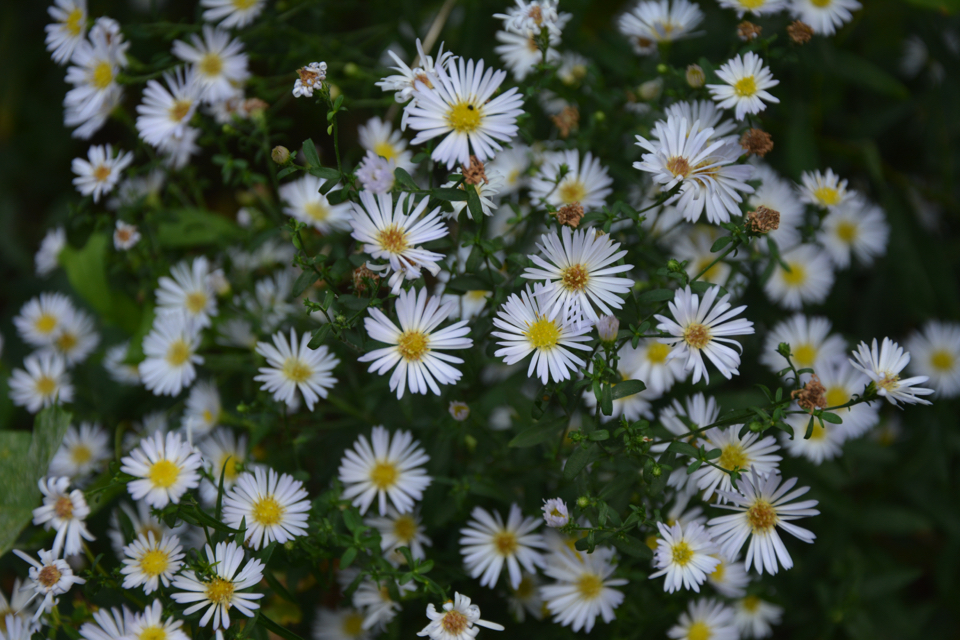
- COMMON NAME(S): Heath Aster ‘Snow Flurry’
- HARDINESS RATING: H7
- FLOWERS: White and yellow
- FLOWERING SEASON(S): Autumn
- SUNLIGHT: Full Sun
- EXPOSURE: Exposed
- SIZE: 0.1-0.5m in height, 0.5-1m spread
Whereas many Asters are purple or pink, the snow flurry (as its name may suggest) is white.
It’s received the RHS AGM too, making it a great choice for British gardens.
Grow your snow flurry in full sun, in any aspect except north facing and make sure it’s not too sheltered.
In the right conditions, this Aster will bring forth white yellow flowers in autumn, offering a great complement to other Asters and flowers in your garden.
9) A. lateriflorus var. horizontalis
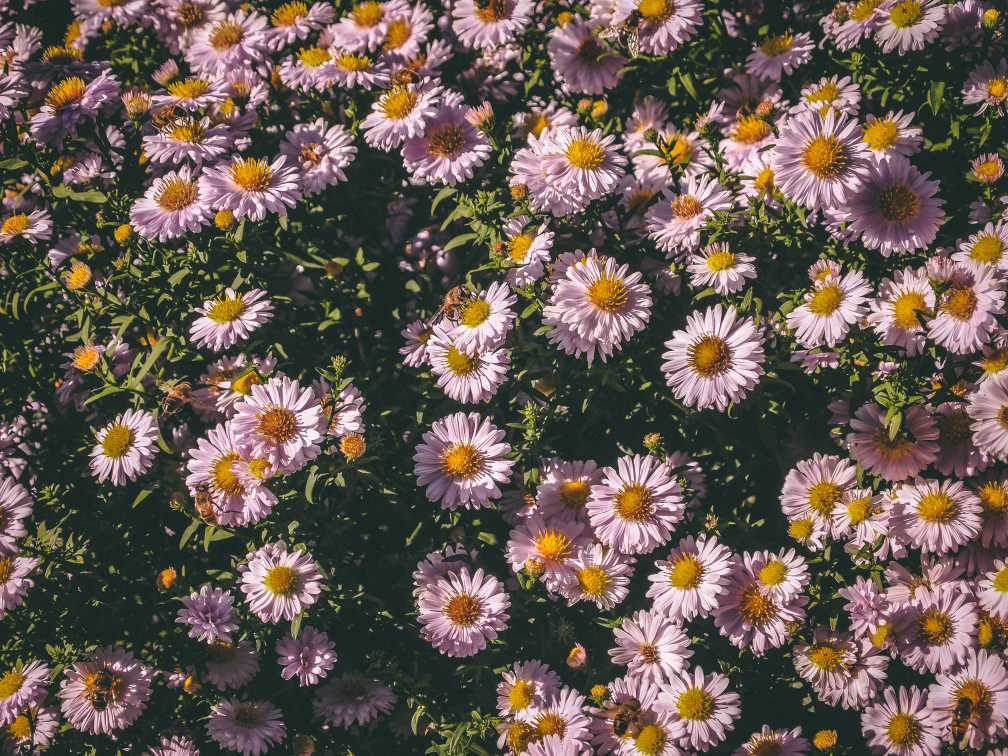
- COMMON NAME(S): Horizontal calico aster
- HARDINESS RATING: H7
- FLOWERS: White and red
- FLOWERING SEASON(S): Autumn
- SUNLIGHT: Full Sun
- EXPOSURE: Exposed
- SIZE: 0.1-0.5m in height, 0.1-0.5m spread
You may also see this called the horizontal calico Aster, referring to its bushy nature and tendency to spread.
You’ll also note how different the colouration is, as you’ll find white petals that fade into a luscious red centre – great for bringing out a different side of Asters in your garden.
This variety is another with the RHS AGM, and is well suited to growing in the UK.
It likes all soils except clayey ones, and requires full sun to do its best.
It’ll bloom in late summer or early autumn, bringing its exciting array of colours to your garden.
10) Symphyotrichum laeve ‘Nightshade’
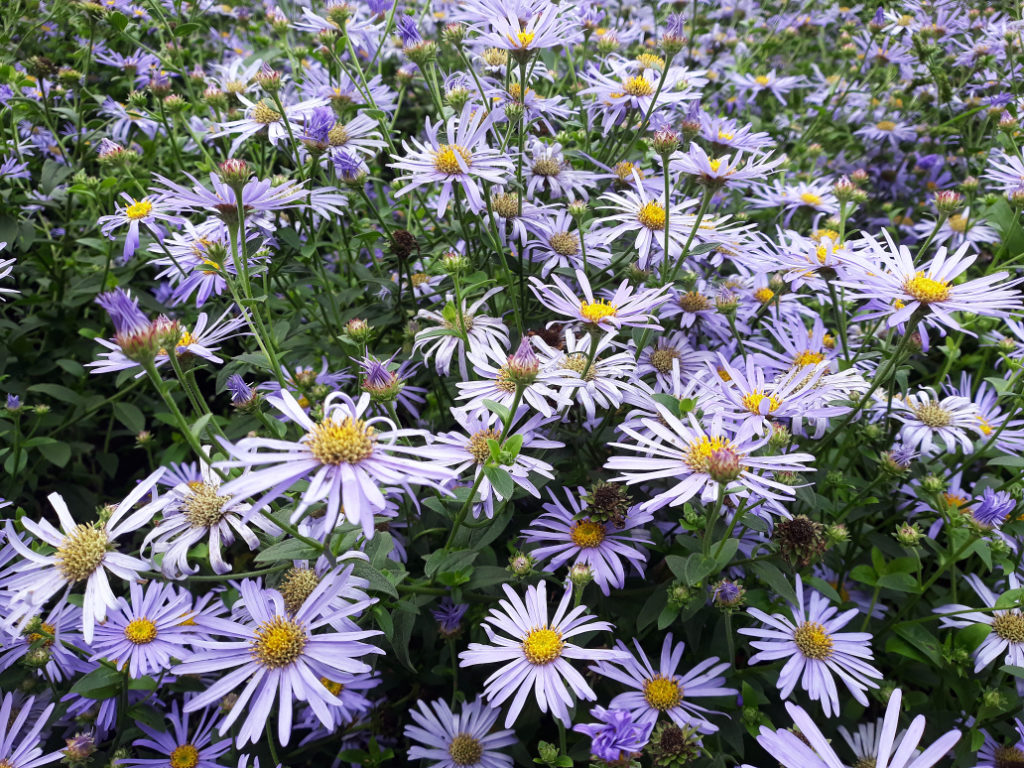
- HARDINESS RATING: H6
- FLOWERS: Purple, blue and yellow
- FLOWERING SEASON(S): Summer / Autumn
- SUNLIGHT: Full Sun / Partial Shade
- EXPOSURE: Exposed / Sheltered
- SIZE: 1-1.5m in height, 0.1-0.5m spread
‘Nightshade’ is a clump-forming Aster with upright stems.
Its purple bloom is indicative of the family, making this a safe bet if you’re going for something characteristic.
This variety will tolerate any soil, and will grow best in full sun or partial shade.
The flowering season is summer through to early autumn, grouping nightshade with other varieties that have a longer season of interest.
11) Symphyotrichum novae-angliae ‘Brunswick’
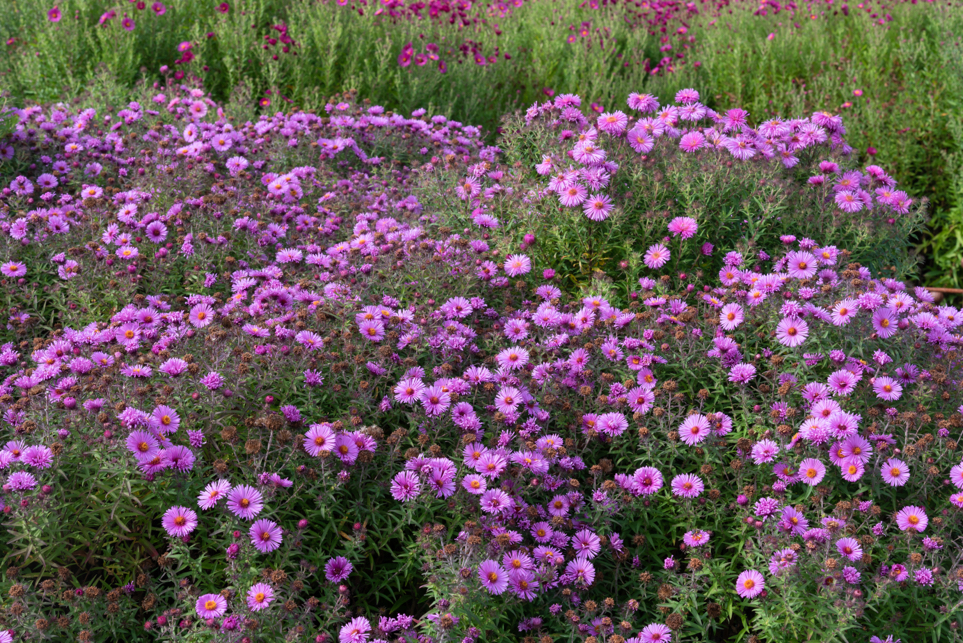
- COMMON NAME(S): New England Aster ‘Brunswick’
- HARDINESS RATING: H7
- FLOWERS: Purple and pink
- FLOWERING SEASON(S): Autumn
- SUNLIGHT: Full Sun / Partial Shade
- EXPOSURE: Exposed / Sheltered
- SIZE: 0.5-1m in height, 0.1-0.5m spread
‘Brunswick’ has the RHS AGM, signifying particular suitability to growth in UK gardens.
This variety has striking pink flowers that catch the eye of even the most stubborn garden appreciator.
Any soil will do for this variety, and it’s not fussy in terms of aspect either, but you should avoid planting it in fully shaded spots.
‘Brunswick’ will flower in autumn, making it a great pairing for other varieties that flower earlier.
